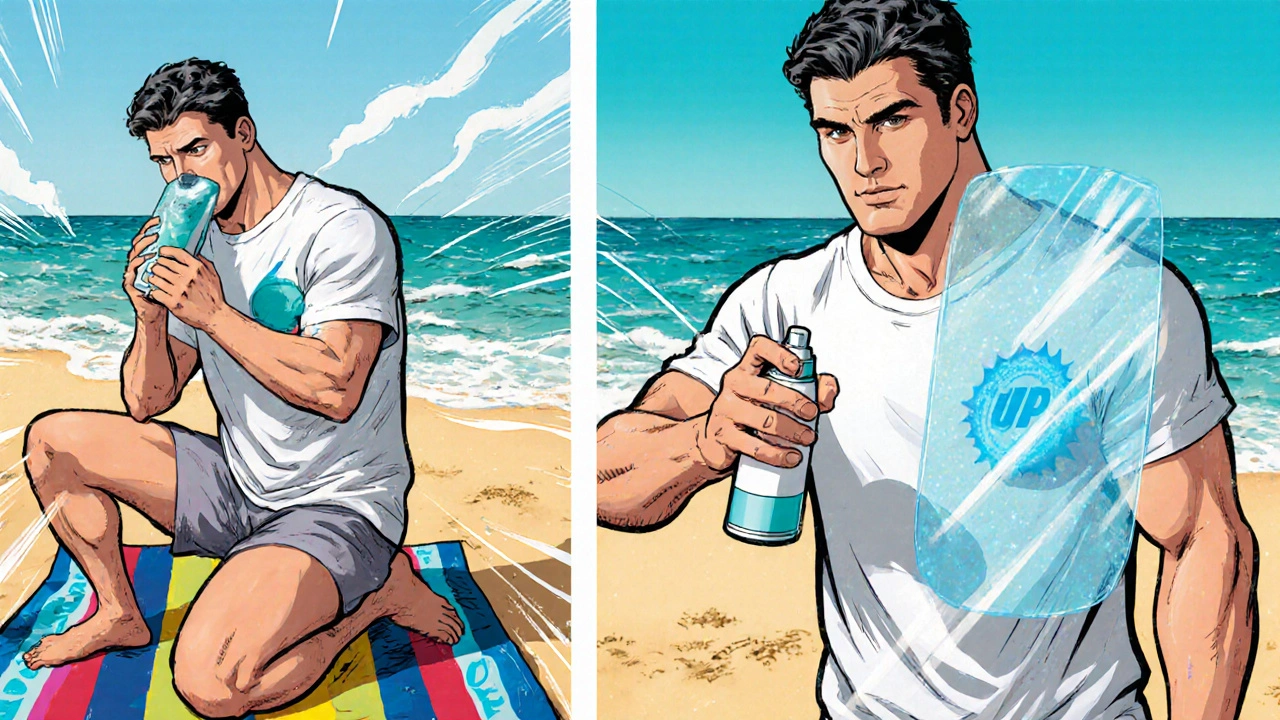Sunscreen Reapplication Calculator
Based on your sunscreen type and activity level, this tool calculates when you need to reapply to maintain protection. Note: For psoriasis management, we recommend water-resistant sunscreens with at least 80 minutes of protection.
Results will appear here
When the temperature soars, keeping plaque psoriasis under control can feel like an impossible juggling act. The sun, sweat, and higher humidity all push flare‑ups into overdrive, but with a few practical tweaks you can stay comfortable and keep the patches at bay.
Why Summer Makes Psoriasis Flare
Plaque psoriasis is a chronic, immune‑mediated skin condition that produces raised, red‑scaly plaques. During summer, two main factors tend to aggravate it:
- Increased sun exposure can trigger a Koebner response where new lesions appear on irritated skin.
- Heat and sweat break down the skin barrier, making it easier for irritants to slip in.
Understanding these triggers is the first step toward a solid summer plan.
Hydration: Moisturize Before You Sunbathe
A well‑hydrated barrier is your best defense. Apply a thick, fragrance‑free moisturizer at least twice a day - especially after showering and before heading outdoors. Look for ingredients like ceramides, glycerin, and hyaluronic acid.
Moisturizer should be a staple in your bag, ready for quick re‑application after swimming or sweating.
Sun Protection Without Skipping the Sun
Sunlight isn’t all villain; moderate UVB can actually improve psoriasis for many people. The trick is to protect the skin while still getting a safe dose of light.
Choose a sunscreen that balances broad‑spectrum protection with a lower SPF (15‑30) if you’re using phototherapy or have a history of sunburns. Here’s a quick comparison:
| Product Type | SPF | Active Filter | Water‑Resistant |
|---|---|---|---|
| Mineral Zinc Oxide | 30 | Zinc Oxide / Titanium Dioxide | Yes (80min) |
| Chemical Avobenzone Blend | 15 | Avobenzone, Octocrylene | No |
| Hybrid (Mineral + Chemical) | 20 | Zinc Oxide + Octinoxate | Yes (40min) |
Apply sunscreen 15minutes before exposure and re‑apply every two hours, or after swimming/sweating.
Medication Adjustments for Warm Weather
Many people stick to the same regimen year‑round, but summer may call for a few changes.
- Topical corticosteroids can become more readily absorbed in warm skin. Consider using a lower‑potency steroid or reducing frequency if you notice thinning.
- If you’re on phototherapy (NB‑UVB), coordinate sessions earlier in the day to avoid the peak sun hours.
- Biologic injections don’t require dose changes for temperature, but keep the injection site clean and cool.

Breathable Clothing: Let Your Skin Breathe
Clothing choices matter. Opt for loose‑fitting, natural fabrics like cotton or bamboo that wick moisture away. Avoid tight sleeves or synthetic blends that trap heat.
For outdoor activities, a lightweight, UPF‑rated shirt offers sun protection without overheating.
Diet and Hydration: Inside‑Out Support
What you eat can influence inflammation. During summer, it’s easier to stay hydrated, so use it to your advantage.
- Increase water intake to at least 2liters per day - more if you’re sweating heavily.
- Include omega‑3 rich foods (salmon, walnuts, flaxseed) to help calm inflammation.
- Limit alcohol and processed sugars, which can trigger flare‑ups for some people.
Handling Sweat and Heat Rashes
Sweat can clog pores and irritate plaques. After a workout or beach day, rinse with cool water and pat skin dry. Then reapply your moisturizer to seal in hydration.
If you develop a heat rash over a plaque, apply a thin layer of a 1% hydrocortisone cream - but only for short periods and under medical guidance.
Stress Management: Keep Calm, Keep Clear
Heat can raise stress levels, and stress is a known psoriasis trigger. Simple practices like morning breathing exercises, short walks in shaded areas, or a quick meditation app can keep cortisol in check.
Quick Summer Psoriasis Checklist
- Apply fragrance‑free moisturizer morning and night.
- Use a broad‑spectrum sunscreen (SPF 15‑30) before any outdoor time.
- Re‑apply sunscreen every 2hours or after swimming/sweating.
- Choose breathable, loose clothing; consider UPF shirts.
- Stay hydrated - at least 2L water daily.
- Adjust topical steroids if skin feels thinner.
- Rinse off sweat promptly; re‑apply moisturizer.
- Practice a daily 5‑minute stress‑relief routine.
Frequently Asked Questions
Can I sunbathe if I have plaque psoriasis?
Yes, but limit exposure, use a sunscreen with a moderate SPF, and monitor your skin for any new lesions. Short, controlled sessions can actually improve symptoms for some people.
Should I stop using my topical steroid in summer?
Not necessarily. Warm skin can increase absorption, so talk to your dermatologist about possibly lowering the potency or frequency during hot months.
Is a humidifier helpful for psoriasis in dry climates?
A cool‑mist humidifier adds moisture to indoor air, which can prevent the skin from drying out, especially when air‑conditioning is on.
What foods should I eat more of in summer?
Focus on omega‑3 rich fish, fresh berries, leafy greens, and plenty of water. These help reduce systemic inflammation.
How often should I reapply sunscreen when I’m sweating?
Every 80minutes for water‑resistant formulas, or sooner if you’ve wiped off the product with a towel.


7 Comments
Darryl Gates
16 October, 2025Make sure you lock in moisture before you head out.
A fragrance‑free, ceramide‑rich cream applied right after shower gives your skin a solid barrier against sweat.
Keep a travel‑size tube in your bag so you can reapply after a swim or a run.
If you notice any tingling, switch to a lower‑potency steroid for a day or two.
Consistency is the key – think of it like a daily workout for your skin.
Carissa Padilha
26 October, 2025Honestly, those “safe” sunscreens are part of the same agenda that keeps us glued to the clinic.
They dump nanomaterials onto our skin while promising protection, but in reality they can aggravate plaques.
Trust me, staying in the shade and using natural oils is the only real solution.
Richard O'Callaghan
4 November, 2025Yo i gotta say i use the same moisturizer i got from my aunt that she swore by for her rash oh and i also put a lil bit of coconut oil after my swim its like magic but watch out for the sun it burns fast lol
Alexis Howard
13 November, 2025if you think coconut oil works just stop it
Malia Rivera
22 November, 2025Summer in America is a celebration of freedom, and our skin should reflect that vigor.
Plaque psoriasis, however, can feel like a foreign invader on our bodies.
The immune system, a complex orchestra, sometimes misfires, leading to those stubborn plaques.
Yet, we are not helpless; we possess the agency to shape our environment.
By selecting breathable cotton garments, we honor the principle of liberty-allowing the skin to breathe.
Hydration, both internal and external, is the cornerstone of a resilient barrier, much like the water that sustains our great rivers.
Aim for at least two liters a day, and supplement with omega‑3 rich foods, because a well‑fed body mirrors a well‑fed nation.
Sunscreen, when chosen wisely-zinc oxide based, SPF 15‑30-protects us without surrendering to the tyranny of over‑shielding.
Apply it fifteen minutes before stepping outdoors, and reapply every two hours as you would check your watch at a border crossing.
Remember that heat can amplify stress, and stress is the silent agitator of inflammation, so a five‑minute meditation is a patriotic act for your own wellbeing.
If you undergo phototherapy, schedule it at dawn, when the sunrise blesses the land with gentle light.
Topical steroids may be potent, but in the summer heat they can pierce deeper, so temper their use like a measured policy.
Biologics remain steadfast, yet keep the injection site cool, as if placing a flag on a sunny hill.
Do not let processed sugars dictate your fate; they are the sugar‑coated propaganda that erodes both health and morale.
Finally, embrace community support-online forums are the modern town squares where we share tactics and triumphs.
In this collective effort, we turn the summer heat from a foe into a forge, strengthening both skin and spirit.
lisa howard
2 December, 2025Oh my god, let me tell you how dramatic this whole summer psoriasis saga feels like! I literally woke up sweating, my plaques looking like tiny battlefields, and I had to scramble for my favorite moisturizer-yes, the one that smells like lavender dreams. Then I threw on a cotton tee that swished in the breeze, feeling like a heroine in a summer blockbuster. I even set a timer on my phone to remind myself to re‑apply sunscreen every two hours, because missing a beat feels like a tragedy. The heat made my skin crack, but I fought back with a cold compress that felt like an icy sigh of relief. I poured a gallon of water into my bottle, slurping like a camel on a desert trek, just to keep my skin hydrated. When I finally sat down to meditate, I imagined my stress melting away like ice cream on a hot sidewalk. And let me assure you, the whole experience was a rollercoaster of emotions, drama, and triumph.
Cindy Thomas
11 December, 2025Okay, let’s get real – the science is crystal clear: omega‑3s, hydration, and proper sunscreen are non‑negotiable. 😏 If you skip any of those, you’re basically inviting a flare‑up party on your skin. Trust the data, trust the dermatologists, and stop over‑thinking every little step.